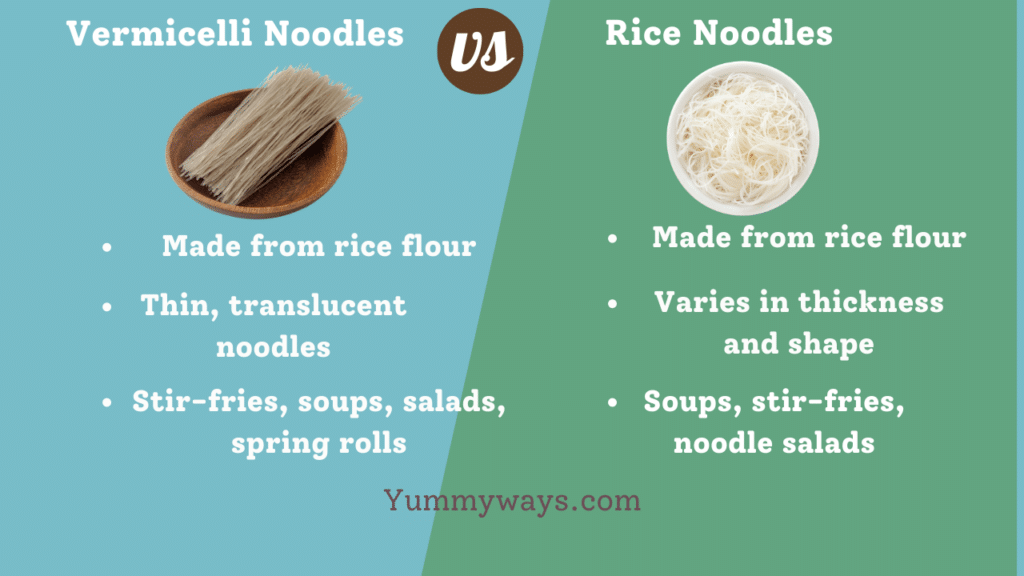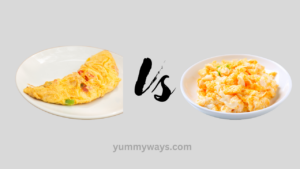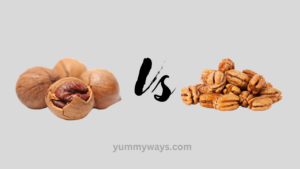Vermicelli and rice noodles are both popular types of noodles used in various cuisines worldwide. While they may appear similar, they differ in texture, appearance, and culinary applications. These are the main differences that people just usually find.
But there are some more differences and similarities between them. If you want to know about them, you must read the whole article. All my discussion is based on vermicelli vs rice noodles. I will cover basic taste differences, nutritional differences, and all others. So, let’s start.

Also Read: Sesame oil vs Peanut oil: A Comprehensive Comparison.
Contents
- 1 What is Vermicelli noodles?
- 2 What is rice noodles?
- 3 Vermicelli vs Rice noodle: An Overview
- 4 Vermicelli vs Rice Noodle: Detail Differences
- 5 Similarities Of vermicelli vs rice noodle
- 6 Vermicelli vs Rice Noodles: Which One Is Healthier?
- 7 Conclusion:
- 7.1 What is vermicelli?
- 7.2 What are rice noodles?
- 7.3 What is the main difference between vermicelli and rice noodles?
- 7.4 Are vermicelli and rice noodles gluten-free?
- 7.5 Can vermicelli and rice noodles be used interchangeably in recipes?
- 7.6 How are vermicelli and rice noodles prepared?
- 7.7 Can vermicelli and rice noodles be used in hot and cold dishes?
- 7.8 How do the textures of vermicelli and rice noodles differ?
- 7.9 Which dishes are made with vermicelli?
- 7.10 Which dishes are made with rice noodles?
- 7.11 Are vermicelli and rice noodles nutritious?
What is Vermicelli noodles?
Vermicelli noodles, also known as rice sticks or rice vermicelli, are a type of thin noodle made from rice flour. The term “vermicelli” is derived from the Italian word for “little worms,” referring to their slender, worm-like appearance.
What is rice noodles?
Rice noodles are a type of noodle made from rice flour. Rice noodles come in different shapes, sizes, and thicknesses, providing versatility in culinary applications. They can found in thin, flat, or wide forms, depending on the specific dish they are used in.
Vermicelli vs Rice noodle: An Overview
I have considered all values and benefits to make this comparison table. Here’s a comparison table on vermicelli vs rice noodles:
| Feature | Vermicelli | Rice Noodles |
| Composition | Made from rice flour | Made from rice flour |
| Appearance | Thin, translucent noodles | Varies in thickness and shape |
| Texture | Delicate and smooth | Slightly chewy |
| Culinary Uses | Stir-fries, soups, salads, spring rolls | Soups, stir-fries, noodle salads |
| Cuisine | Primarily used in Southeast Asian dishes | Widely used in Asian cuisines |
| Taste | Neutral, absorbs flavours of ingredients | Mild, slightly sweet |
| Examples | Thai Pad Thai, Vietnamese spring rolls | Chinese Chow Fun, Pho |
Also Read: The Ultimate Comparison: Lentils vs Quinoa
Vermicelli vs Rice Noodle: Detail Differences
Composition
Vermicelli noodles are exclusively made from rice flour. Rice noodles, on the other hand, are a broader category that includes noodles made from rice flour but can also include other ingredients like tapioca starch or cornstarch.
Appearance
Vermicelli noodles are thin and translucent, resembling long, thin strands. Rice noodles, on the other hand, come in different shapes and sizes, ranging from thin to flat to wide. Depending on the dish, they are thin and round, flat and wide, or even in other specific shapes.
Texture
Vermicelli noodles have a delicate and smooth texture when cooked. They are tender and easily break apart. Rice noodles have a slightly chewy texture. The texture can vary depending on the thickness and width of the noodles. Thinner rice noodles are more delicate, while wider ones have more chewiness.
Culinary Uses
Vermicelli noodles are used in Southeast Asian cuisines like Thai, Vietnamese, and Singaporean. They are often used in stir-fries, soups, salads, and spring rolls. Rice noodles have a broader range of culinary uses and are widely used in Asian cuisines like Chinese, Thai, Vietnamese, and Malaysian. They are used in soups, stir-fries, noodle salads, and as a base for popular dishes like Pad Thai and Pho.
Taste
Vermicelli noodles have a neutral taste, allowing them to absorb the flavors of the ingredients they are cooked with. Rice noodles have a mild, slightly sweet taste, adding a subtle flavor to their dishes.
Cooking Method
Vermicelli noodles are usually soaked in water until they become soft and pliable. They can also briefly boil. Rice noodles are soaked in hot water to soften them before being used in a recipe. Thinner rice noodles require less soaking time, while wider ones may need slightly longer soaking or even brief boiling.
Regional Variations
Vermicelli noodles are primarily associated with Southeast Asian cuisines like Thai and Vietnamese. Rice noodles have a broader geographic range and are used in various Asian cuisines, including Chinese, Thai, Vietnamese, and Malaysian.
Also Read: Acorn vs Chestnut: Which One is the Better Nut
Similarities Of vermicelli vs rice noodle
Ingredient
Both vermicelli noodles and rice noodles are made from rice flour. This makes them suitable for individuals with wheat or gluten sensitivities or dietary restrictions.
Versatility
Both noodles are highly versatile and can be used in various dishes. They can incorporate into stir-fries, soups, salads, spring rolls, noodle-based dishes, and more.
Texture
While slight variations in thickness and width may vary, vermicelli and rice noodles are soft and chewy when cooked. The exact texture can also adjust by adjusting the cooking time or method.
Cooking Process
Vermicelli and rice noodles have similar cooking processes. They are soaked in hot water until they become soft and pliable before being used in a recipe. The cooking time may vary depending on the thickness and width of the noodles.
Absorption of Flavors
Both noodles have a relatively neutral taste and readily absorb the flavors of the ingredients they are cooked with. This quality allows them to enhance and complement the overall flavor profile of the dish.
Dietary Considerations
As rice-based noodles, both vermicelli and rice noodles are suitable for vegetarian, vegan, and gluten-free diets. Many individuals with diverse dietary needs and preferences can enjoy them.
While vermicelli and rice noodles have unique characteristics, these similarities make them popular in various culinary applications and ensure their adaptability to different cuisines and dietary preferences.
Also Read: Beets vs Turnips: A Comprehensive Comparison
Vermicelli vs Rice Noodles: Which One Is Healthier?
I have told you about the basic differences in the above sections of the discussion. You might get a clear idea about which one suits you. But let’s discuss that again in more specific detail.
Vermicelli noodles tend to have a slightly higher calorie content than rice noodles. This is due to their thinner and more delicate texture. On the other hand, Rice noodles may have slightly lower carbohydrate content compared to vermicelli noodles.
Vermicelli noodles serve as the best source of carbohydrates on top. It is essential for health. These noodles are a good food for those who want to diet as they are low in protein. Two: Vermicelli noodles are slightly lower in calories than rice noodles and are a good choice for those who want to consume fewer calories. Considering your physical aspect, it should decide which will benefit you.
Vermicelli and rice noodle are considered part of a balanced diet in terms of healthy foods. Which noodles you need depends on the nutrients you want, and you can choose any 1 of these 2 noodles according to your needs. It should also note what ingredients are in which noodles and what noodles are added to them because it depends on the seasoning and your preference. This information gives you a clear idea of which noodles are right for you.
Also Read: Dates vs Figs: Which is Healthier for You?
Conclusion:
I always try to give you the best comparison of many foods and cooking items. My discussions help you to find info about different food items. In this case, vermicelli and rice noodles, all differences and similarities are shown; this is enough to differentiate these two.
There are more discussions on my blog where you will find more valuable discussions. They will also help you to find general info about them. That was all for today. Thanks for reading from us.
What is vermicelli?
Vermicelli refers to thin noodles made from wheat, rice, or mung bean flour. In this context, we will focus on rice vermicelli, the most use type in Asian cuisines.
What are rice noodles?
Rice noodles are noodles made primarily from rice flour and water. They are a staple in various Asian cuisines and come in different shapes and sizes, ranging from thin and transparent to wide and flat.
What is the main difference between vermicelli and rice noodles?
The main difference lies in the ingredients used to make them. Vermicelli can make from various grains, including wheat, while rice noodles are exclusively made from rice flour. Additionally, vermicelli tends to be thinner and more delicate, while rice noodles come in various widths and thicknesses.
Are vermicelli and rice noodles gluten-free?
Rice vermicelli and rice noodles are gluten-free since they are made from rice flour. However, it’s essential to check the packaging or verify with the manufacturer, as some varieties may include additives or blends that contain gluten.
Can vermicelli and rice noodles be used interchangeably in recipes?
While vermicelli and rice noodles share some similarities, they have distinct textures and flavours. They can be used interchangeably in specific recipes, but the results may differ slightly. It’s best to follow the specific recommendations of the recipe you’re working with.
How are vermicelli and rice noodles prepared?
Both vermicelli and rice noodles are usually prepared by soaking them in hot water until they become soft and pliable. The soaking time may vary depending on the thickness of the noodles. Once softened, they can add to soups, stir-fries, salads, or as a base for various dishes.
Can vermicelli and rice noodles be used in hot and cold dishes?
Yes, vermicelli and rice noodles are versatile and can be used in various hot and cold dishes. Vermicelli is used in soups, stir-fries, and spring rolls. Rice noodles are popular in pad Thai, pho, and cold noodle salads.
How do the textures of vermicelli and rice noodles differ?
Vermicelli tends to have a softer and more delicate texture than rice noodles. Rice noodles can have varying textures depending on their thickness, ranging from thin and tender to wider and chewier options.
Which dishes are made with vermicelli?
Vermicelli is widely used in Asian cuisine. Some popular dishes include Singapore-style vermicelli, vermicelli bowls, bun cha (Vietnamese grilled pork with noodles), and various noodle soups.
Which dishes are made with rice noodles?
Rice noodles are prevalent in pad Thai, pho (Vietnamese noodle soup), char kway teow, mee goreng, and drunken noodles. They are also used in stir-fries, spring rolls, and cold noodle salads.
Are vermicelli and rice noodles nutritious?
Both vermicelli and rice noodles primarily provide carbohydrates and are relatively low in fat. Their nutritional content can vary based on the specific brand, ingredients, and serving sizes. It’s always advisable to check the packaging for detailed nutritional information.

